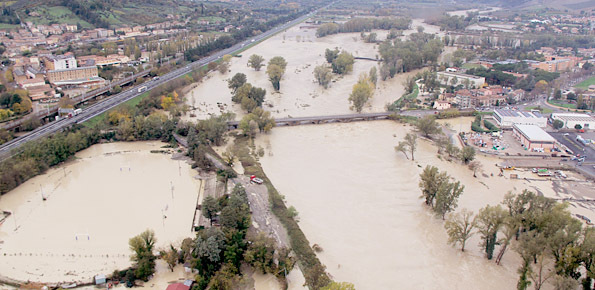Flood forecasting and hydraulic risk
Flood forecasting and predictive uncertainty assessment, hydraulic risk estimate also considering the hydraulic structure vulnerability (FLORIS)

Background
The project is focused on flood forecasting and hydraulic risk, i.e. the assessment of the effects of flooding in flood-prone areas also involving the vulnerability assessment of the hydraulic structures (dams, leaves, bridges, etc.).
The effects of flood events are not completely eliminated by structural measures, therefore it is necessary to develop complementary non-structural measures, such as real-time Flood Forecasting and Warning Systems (FFWS). Forecasting models are a fundamental component of FFWSs. The forecast of water level/discharge with appropriate forecast horizons supports decision-makers in their activity aimed to mitigate the negative effects of floods (management of the emergency in real time). However, all models are imperfect and quantifying the uncertainty about the future evolution of the full event becomes fundamental (predictive uncertainty).
Furthermore, the assessment of the flooding impact in the flood-prone areas may require the use of two-dimensional hydraulic models able to consider the complexity of the morphology but, at the same time, also the need to limit the calculation complexity. Therefore, it is important to have robust tools to analyze the main processes of the surface runoff formation and to deal with the hydraulic risk also when earthen levees are involved and could failure (levees vulnerability and residual hydraulic risk).
Purpose
Development of a probabilistic flood forecasting procedure in real-time (90% uncertainty confidence band) based on all available information.
Identification of guidelines for the selection of the most suitable approach for hydraulic hazard study and development of a procedure for the analysis of the residual hydraulic hazard, even in real time.
The project aims to improve flood forecasting systems, particularly in terms of predictive uncertainty estimate, and to extend the analysis of new hydraulic two-dimensional models addressed to evaluate the effects of flooding in flood-prone areas also when vulnerable earthen levees are involved.
Methods
The predictive uncertainty is estimated through probabilistic approaches. In particular, a Bayesian method (Model Conditional Processor, MCP) is used in the estimation of the uncertainty both considering multi-model scenarios and multi-temporal scenarios (different forecasting horizons).
In the analysis of the flooding effects, widely used hydraulic models of various types are considered (one-dimensional, quasi-two-dimensional, two-dimensional and simplified approaches such as the Kinematic Storage Model) but also experimental two-dimensional models based on variable calculation grid are investigated along with expeditious approached for levees vulnerability assessment.
Results
1) Improved forecasting modeling and operative estimate of predictive uncertainty.
2) Estimation of hydraulic hazard and delineation of flood-prone areas with appropriate approaches.
Conclusions
The study carried out on the estimation of the predictive uncertainty allowed/will allow to define a fundamental probabilistic forecast to be integrated in real-time monitoring, forecasting and management systems.
The analysis of the hydraulic hazard and of flood-prone areas has allowed/will allow the comparison between different approaches for the delineation of flooded areas and to identify a expeditious methodology for the analysis of the levee vulnerability even in the presence of structural discontinuities.




 Internal contact person: silvia barbetta -
Internal contact person: silvia barbetta -